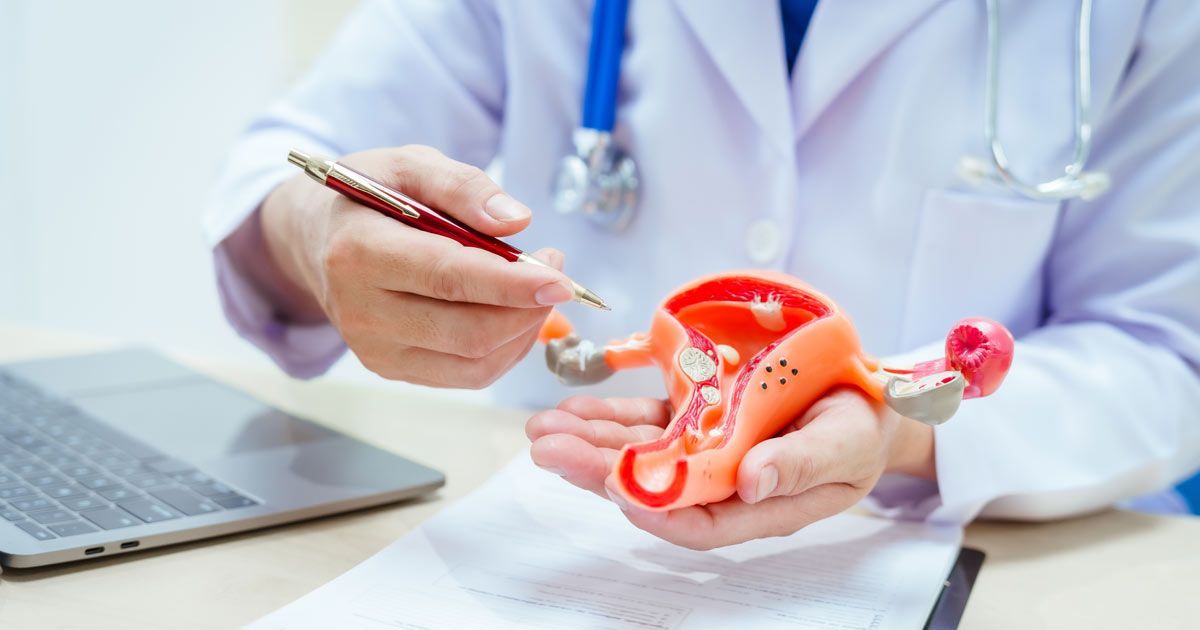Endometriosis Treatments NYC - Dr. John Salerno

Endometriosis Therapy by Salerno Wellness in Manhattan, NY and Connecticut
Hi, I’m Dr. John Salerno and I know how difficult it can be to live with Endometriosis. From daily pain and fatigue to concerns about how it will impact your life, this condition can really affect your quality of life. Please know that you are not alone. I have over 30 years of experience helping patients discover the root cause of their symptoms and implement integrative and functional medical treatments that are tailored to your needs. We can get to the bottom of this together and develop a care plan that will put an end to your pain and suffering.
-Dr. John Salerno
What is Endometriosis?
Endometriosis is a chronic medical condition that occurs when the uterine tissue (endometrium) grows in other places outside of the uterus. Endometriosis tissue can stick to other parts of your reproductive system, like your ovaries and fallopian tubes, or other parts of your pelvis lining, like the ligaments or tissues that support your intestines or bladder. Endometriosis acts like regular uterine lining by thickening, breaking down and bleeding every month during the menstrual cycle. But unlike normal menstrual bleeding, the blood has no way to exit the body and it builds up.
This causes irritation and inflammation in the body that can lead to scarring and adhesions (connective bands of fibrous scar tissue) that can attach to organs and cause them to bind to each other. It can affect more than one system in the body, which is why the symptoms and side effects are so wide-ranging. The cause of endometriosis is unknown, although many theories have been suggested. If it’s left untreated, it can progressively worsen over time.
Symptoms of Endometriosis
Symptoms of Endometriosis can be different for everyone. But the most common symptoms are not only difficult to live with, but they can be physically and emotionally devastating.
- Pelvic Pain - Endometriosis can cause chronic pain in the pelvic area, especially during menstruation. Pain can range from dull aching to sharp or stabbing sensations. Pain can get worse over time and can be constant throughout the month instead of just during menstruation.
- Pain During Sex - Pain during or after sex can occur with endometriosis, because scar tissue or adhesions can cause pelvic muscles and organs to shift during intercourse. This can cause pain as these organs are moved.
- Heavy Menstrual Bleeding - Endometriosis can cause periods to be heavier or last longer than usual. This condition is called menorrhagia. In some cases, spotting between periods can also occur. Excessive or prolonged bleeding can lead to fatigue and anemia.
- Infertility - Infertility affects between 30% to 50% of people with endometriosis. The condition can impact ovulation or implantation or there may be blockages in fallopian tubes from scar tissue and adhesions.
- Fatigue - Many people with endometriosis also experience fatigue. It’s a common, although often overlooked, symptom of endometriosis. The body is constantly trying to repair the effects of inflammation, which can sap energy levels.

Meet Christina Rosiello, Nurse Practitioner
Christina Rosiello, our Nurse Practitioner has been working with Dr. John Salerno for many years. Christina is knowledgeable and experienced in all of Dr. Salerno's integrative and functional medical care techniques and has quickly become a patient favorite. Although well versed in all aspects of Salerno Wellness care, Christina is especially sought out by patients who may feel more comfortable with a woman as it pertains to female health issues such as PDMM, PMS, or any other hormonal or health issue. Contact us to learn more about scheduling an appointment with Christine.
Causes of Endometriosis
The exact cause of endometriosis is not fully understood. There are several potential causes that are suspected by researchers.
- Hormonal Imbalances - An imbalance of hormones, or an environment that is more sensitive to these hormones, can lead to endometrial growths.
- Retrograde Menstruation - This condition, also called menstruation, occurs when menstrual blood flows backwards through the fallopian tubes and into the pelvic cavity, where it implants and grows.
- Immune System Dysfunction - This condition causes the immune system to fail to recognize the endometrial cells growing outside the uterus.
- Genetics - This condition seems to run in families, and may have a genetic link.
- Environmental Factors - Exposure to toxins in the environment can lead to hormone disruption and result in endometriosis.
- Medical Procedures - There are certain medical procedures, like C-sections, that can sometimes spread the uterus tissue during the procedure and lead to the growth of endometrial cells.
Related Conditions That Can Be Treated by Dr. Salerno
Endometriosis does not happen in isolation. It’s often accompanied by other medical conditions that can also aggravate symptoms. These conditions are part of a complex puzzle, and recognizing and resolving them is an important part of my approach to treatment.
- Polycystic Ovary Syndrome (PCOS) - Patients with PCOS often suffer from hormonal imbalances. Endometriosis can make symptoms worse. Treating one or both conditions can help restore a normal hormonal profile.
- Irritable Bowel Syndrome (IBS) - IBS is very common in those with endometriosis and is often also involved. This condition is characterized by abdominal pain, irregular bowel movements, bloating, and other digestive issues. Both IBS and endometriosis can produce similar symptoms, which is why it’s important to work with a doctor who can recognize both conditions and treat them as part of an overall care plan.
- Pelvic Floor Dysfunction - Tight or weak pelvic floor muscles are a common complication of endometriosis and pelvic pain. This dysfunction must also be addressed to alleviate pain.

Candidates for Endometriosis Treatment
Candidates for treatment can be at any stage of endometriosis. If you’re suffering from unexplained pelvic pain, heavy or irregular menstrual bleeding, or unexplained infertility, it may be time to consider treatment.
My approach to treatment begins with a personalized care plan and laboratory testing to find out what may be at the root of your symptoms. This could be hormonal imbalances, nutritional deficiencies, or something else.
Early detection and treatment is always ideal, but even people with long-standing symptoms can find relief with a comprehensive, personalized treatment program. Age is not a factor either. I can help teenagers who are just beginning to deal with symptoms, as well as women who have entered menopause and are now dealing with problems. Many of my patients have had negative experiences with traditional therapies and are seeking a new approach and a fresh set of eyes.
How Conventional Medicine Typically Treats Endometriosis
Conventional medicine typically treats endometriosis by focusing on symptom management and slowing the progression of the condition. Here are the common approaches:
- Pain Management: Over-the-counter pain relievers like ibuprofen or naproxen are often recommended to manage mild to moderate pain. For more severe pain, prescription medications may be used.
- Hormonal Therapy: Hormonal treatments aim to regulate or suppress the hormones that influence the menstrual cycle, thereby reducing the growth of endometrial-like tissue. Common options include:
- Birth control pills, patches, or vaginal rings to control hormone levels.
- Gonadotropin-releasing hormone (GnRH) agonists and antagonists to induce a temporary menopause-like state.
- Progestin therapy, such as intrauterine devices (IUDs) or injections, to reduce or stop menstruation.
- Surgical Intervention: For severe cases or when other treatments are ineffective, surgery may be performed to remove endometrial tissue, scar tissue, and adhesions. This can be done through:
- Laparoscopy: A minimally invasive procedure to excise or burn away endometrial growths.
- Hysterectomy: In extreme cases, the removal of the uterus (and sometimes ovaries) may be considered, though this is typically a last resort.
- Fertility Treatments: For individuals struggling with infertility due to endometriosis, assisted reproductive technologies like in vitro fertilization (IVF) may be recommended.
Conventional treatments often focus on managing symptoms rather than addressing the root causes, which is why some patients seek complementary or integrative approaches to enhance their care.
How Dr. John Salerno's Treats Endometriosis
My approach to treating endometriosis is medical-based and involves holistic therapies to target and eliminate root causes of this condition. I begin with a complete review, which includes advanced laboratory testing and imaging if necessary. Hormonal balance is one of the primary targets of endometriosis treatment. The body may need support in the form of natural therapies, in addition to or instead of traditional options that help regulate hormones.
Diet modification can help to reduce inflammation. Patients also benefit from the targeted use of nutritional supplements to support and optimize the immune system. For pain, some patients may experience fast and long-lasting relief with intravenous (IV) vitamin infusions.
Possible Side Effects of Treatment
Like all treatments, there are potential side effects. With my functional and complementary methods, many of these are reduced or avoided. For instance, nutritional therapies will be carefully planned to minimize the potential for gastrointestinal upset. Hormonal treatments may initially cause minor mood or energy level fluctuations. If you have minimally invasive surgery, there will be a normal recovery period with some inflammation and discomfort.
What Can Happen if Endometriosis is Left Untreated?
Left untreated, endometriosis will usually get worse over time, and symptoms can become more severe. Chronic pain is common with endometriosis, but it can become debilitating when left untreated. It can impact work and relationships and make everyday life a challenge. Fertility is also impacted if the condition is not treated and the adhesions and scar tissue continue to develop. In severe cases, advanced endometriosis has even been linked to certain forms of cancer.
Endometriosis Patient Case Study
Eva, 34 years old, came to me for evaluation after suffering from chronic pelvic pain and fatigue for years. She had been to several different specialists, but had received no answers. She was treated for anxiety by one doctor, and received pain medications from several others. But nothing seemed to help. After taking a closer look at her health, I also found that she had low vitamin D levels and a history of PCOS. We began a treatment program that included hormone therapy, anti-inflammatory nutrition and IV vitamin infusions. Eva was able to reduce her pain by 60% within six months. Over time, she gained back her energy and was even able to get pregnant and have a child on her own, something she had given up on entirely.
Why Patients Choose Dr. John Salerno
Many people have chosen my practice because I look beyond just treating the symptoms of a condition like endometriosis to treating the whole patient. My integrative, functional approach means I leave no stone unturned, from your diet to your hormones to your immune system. I have spent more than 30 years helping people get their lives back and I’m not interested in short-term or quick fixes. I’m focused on long-term solutions that will restore balance to your life and reduce your risk for future health problems.
Contact Dr. John Salerno For A Consultation on Treating Your Endometriosis
Endometriosis is a painful and frustrating condition that can affect your whole life. But you don’t have to live with it. At Salerno Wellness, we combine complementary and integrative therapies to find the root cause of your problem and give you the relief you deserve. Contact us today to learn more about how I can help you take back control of your health.
Please contact us today.
Additional References
- Understanding Endometriosis: From Symptoms to Treatment - FDA
- About Endometriosis - US Department of Health and Human Services National Institutes of Health



